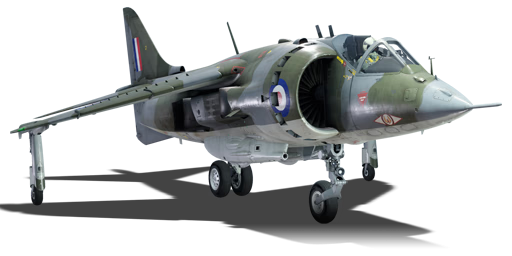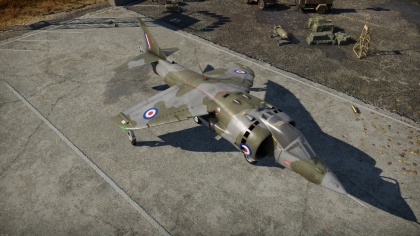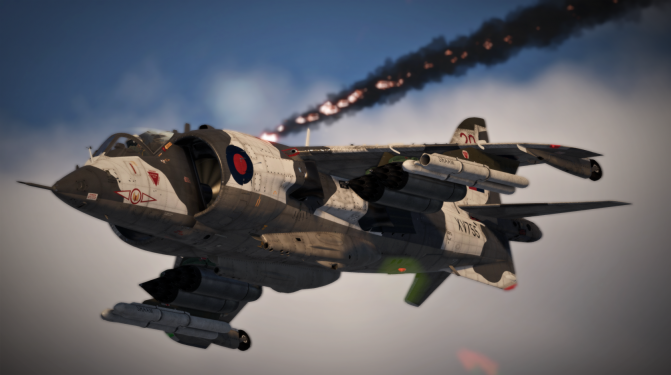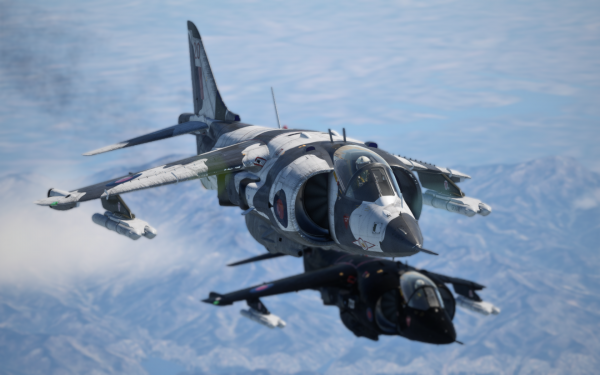Harrier GR.1
Contents
| This page is about the British jet fighter Harrier GR.1. For other versions, see Harrier (Family). |
Description
The Harrier GR.1 is a premium rank VI British jet fighter
with a battle rating of 10.0 (AB) and 9.7 (RB/SB). It was introduced in Update "New Power". Like all members of the Harrier family, the Harrier GR.1 is a VTOL aircraft with thrust vectoring nozzles, which allow it to take off and land vertically.
General info
Flight performance
| Characteristics | Max Speed (km/h at 0 m - sea level) |
Max altitude (metres) |
Turn time (seconds) |
Rate of climb (metres/second) |
Take-off run (metres) | |||
|---|---|---|---|---|---|---|---|---|
| AB | RB | AB | RB | AB | RB | |||
| Stock | 1,124 | 1,118 | 12192 | 32.5 | 33.9 | 63.0 | 61.5 | 550 |
| Upgraded | 1,143 | 1,133 | 31.5 | 32.0 | 98.5 | 80.0 | ||
Details
| Features | |||||
|---|---|---|---|---|---|
| Combat flaps | Take-off flaps | Landing flaps | Air brakes | Arrestor gear | Drogue chute |
| X | ✓ | ✓ | ✓ | X | X |
| Limits | ||||||
|---|---|---|---|---|---|---|
| Wings (km/h) | Gear (km/h) | Flaps (km/h) | Max Static G | |||
| Combat | Take-off | Landing | + | - | ||
| 1191 | 648 | N/A | 833 | 556 | ~14 | ~6 |
| Optimal velocities (km/h) | |||
|---|---|---|---|
| Ailerons | Rudder | Elevators | Radiator |
| < 648 | < 950 | < 790 | N/A |
Engine performance
| Engine | Aircraft mass | ||||||
|---|---|---|---|---|---|---|---|
| Engine name | Number | Basic Mass | Wing loading (full fuel) | ||||
| Rolls-Royce Pegasus Mk.101 | 1 | 5,868 kg | 439 kg/m2 | ||||
| Engine characteristics | Mass with fuel (no weapons load) | Max Takeoff Weight | |||||
| Weight (each) | Type | 10m fuel | 20m fuel | 30m fuel | 34m fuel | ||
| 1,640 kg | Vectored-thrust low-bypass turbofan | 6,542 kg | 7,216 kg | 7,890 kg | 8,160 kg | 12,679 kg | |
| Maximum engine thrust @ 0 m (RB / SB) | Thrust to weight ratio @ 0 m (WEP) | ||||||
| Condition | 100% | WEP | 10m fuel | 20m fuel | 30m fuel | 34m fuel | MTOW |
| Stationary | 8,708 kgf | 9,240 kgf | 1.41 | 1.28 | 1.17 | 1.13 | 0.73 |
| Optimal | 8,708 kgf (0 km/h) |
9,240 kgf (0 km/h) |
1.41 | 1.28 | 1.17 | 1.13 | 0.73 |
| The Pegasus engine loses a significant amount of thrust as your speed increases |
Survivability and armour
The Harrier GR.1 has no armour. The engine and all fuel tanks are packed in a tight cluster in the centre of the fuselage.
Armaments
Offensive armament
The Harrier GR.1 is armed with:
- 2 x 30 mm ADEN Mk.4 cannons, belly-mounted (200 rpg = 400 total)
Suspended armament
The Harrier GR.1 can be outfitted with the following ordnance:
- Without load
- 5 x 500 lb H.E. M.C. Mk.II bombs (2,500 lb total)
- 4 x 500 lb H.E. M.C. Mk.II bombs (2,000 lb total)
- 3 x 1,000 lb G.P. Mk.I bombs (3,000 lb total)
- 4 x 1,000 lb G.P. Mk.I bombs (4,000 lb total)
- 108 x SNEB type 23 rockets
- 4 x SRAAM missiles
- 4 x SRAAM missiles + 3 x 500 lb H.E. M.C. Mk.II bombs (1,500 lb total)
- 4 x SRAAM missiles + 3 x 1,000 lb G.P. Mk.I bombs (3,000 lb total)
- 4 x SRAAM missiles + 72 x SNEB type 23 rockets
Usage in battles
Despite having a weaker engine than other members of the Harrier family, the Harrier GR.1 still possesses exceptional acceleration and rate of climb. Coupled with a decent selection of load-outs (including the extremely powerful SRAAM missiles), and VTOL capability; this makes the Harrier GR.1 a very potent aircraft for both air-to-air combat and ground attack.
Generally a good way to start the game in the Harrier GR.1, when you are are facing aircraft around your BR or lower, is to takeoff and use your incredible accelerate and climb rate to get up and above the enemy aircraft. Climb slightly to the side of the battle and once you have sufficient altitude begin to swoop down on enemy aircraft below you, dispensing of them with your SRAAMs, or ADEN cannons. When climbing it is best to keep the throttle at only 90-95%, and to not use WEP; even at 90% throttle the mighty Pegasus engine is still capable of giving the Harrier a very impressive climb rate. This is advisable as the Harrier only has about 90 seconds of total WEP time, and there are better uses for it than climbing; in addition the Pegasus engine is not designed to be run a full power for extended periods of time and will overheat if left on 100% throttle for too long. As the battle goes on you can drop down to lower altitude to engage your enemies; you should generally avoid turn fighting, instead opting to make high speed attacks from the side of enemies. How much fuel you take is up to you: the minimum load of 10 minutes gives you an incredible thrust to weight ratio and can be enough for short battles, however it is not enough to last longer battles without refuelling.
When facing enemy aircraft which are mostly above your BR (i.e. top tier jets) you need to be much more cautious when taking the climbing approach. Against top tier jets the Harrier's climb rate is less impressive, and being at high altitude leaves you vulnerable to attack from long range semi-active radar homing air-to-air missile, an issue exacerbated by the Harrier GR.1's lack of a radar warning receiver. In such battles it is better to stay low and fast, picking off top tier jets with fast approaches from the side, or by forcing an overshoot (thrust vectoring helps with this).
The primary air-to-air weapon of the Harrier GR.1 are its four incredibly powerful SRAAM missiles. The SRAAMs are missiles of extremes, outside of 1.0 - 1.2 km they are near useless, however once you get to within 1.2 km of your target they transform into one of the hardest missiles in the game to dodge. The thrust vectoring nature of SRAAMs make them extremely manoeuvrable and hard to dodge, but mean the missiles cannot manoeuvre at all after the motor burns out, significantly limiting their range. To get the most out of SRAAMs you need to play to their advantages, the SRAAMs' poor range means that firing them from directly behind a target while chasing them is not the best idea unless you are very close, have a speed advantage, or the target is manoeuvring. Instead, the optimal way to use SRAAMs is to approach perpendicular to the target and attempt to obtain a lock from as far out as possible. With a lock obtained you should close on the target from the side; as you approach the 1.2 km mark you should turn into the target and "lead" the missile like you would your guns. Fire the missile within 1 km of the target and there is little they will be able to do about it; the SRAAM's extreme manoeuvrability allows them to follow the target through most evasive manoeuvres. A video of this method can be seen to the right. A key weakness of the SRAAMs (other than their limited range) is that they are highly susceptible to flares. You should either pick targets not equipped with flares, or if a target is equipped with flares try to attack when they are distracted or approach from an angle where you will hopefully not be noticed until it is too late.
While the addition of SRAAMs makes the Harrier GR.1 a potent fighter, it was designed as a ground attack aircraft, and it is very capable at filling this role in-game. The Harrier GR.1 has a good selection of bombs or rockets, coupled with a ballistic computer providing CCIP this makes the Harrier a powerful ground attacker in both air and ground battles. In air battles the two ADEN cannons are very effective at killing ground targets up to medium tanks and light pillboxes (a task made easier with the ballistic computer), and have a plentiful ammo supply. The ability to reliably kill ground targets is useful for both opportunistic attacks for extra RP and for winning matches (if it comes to it).
The defining feature of the Harrier GR.1 is of course its VTOL (Vertical Take Off and Landing) capability; while this might at first seem like a "party trick" with limited utility there are situations where it can be surprisingly useful. Obviously VTOL allows for short/vertical takeoffs, and while conventional takeoffs are usually the better option (you typically get up to speed quicker) there are occasions where such capability is desirable (e.g. getting out of the way of players strafing the airfield). A more useful feature of VTOL on takeoff is that it allows the Harrier to take-off from aircraft carriers. Taking off from carriers allows you approach the battle from a different angle, sometimes this an be tactically useful depending on how you want to play the match. Where carriers particularly come in useful is if you need to rearm, but suspect the enemy is waiting for you at your main airfield. Some maps allow you to chose from multiple aircraft carriers to spawn on. These will be one of the three modern carriers; there is little to choose from between USS Forrestal and HMS Ark Royal (the Forrestal is a bit larger), however Baku is a little more interesting. If you go with USS Forrestal and HMS Ark Royal you get a speed boost on conventional takeoff (simulating a catapult launch); on Baku you get no such boost, requiring you to use your VTOL capability, but the Baku does have significantly better anti-air protection than the other carriers. Regardless of which aircraft carrier you land on the Harrier has no tail hook or drogue chute, so you will need to make use of your VTOL capability when landing.
Where the Harrier's VTOL capability makes the aircraft unique is in the ability to vector the exhaust nozzles to any angle you want during forward flight, at any speed. Vectoring the nozzles will typically lead to very rapid speed loss and therefore should only be done in certain situations. The most basic use of thrust vectoring is for forcing an overshoot, with the air brake deployed and nozzles fully vectored (so pointing slightly in reverse) the Harrier will slow down quite a bit faster than other aircraft; you can use this to make the aircraft on your tail overshoot then hit them with an SRAAM as they fly past. This technique should only be used as a last resort in one-on-one battles though, as you will lose all of your energy and leave you vulnerable to any other enemy aircraft in the area. A more advanced use is to vector the nozzles during turns to enhance turning performance; while deflecting the nozzles will make you lose speed quicker and thus hurt sustained turning performance it can sometimes give you the little bit extra instantaneous turning performance you need to get guns on target, or dodge an enemy attack. You will need to practice and find for yourself the correct balance between turning performance and speed loss in different situations. A more obscure situation in which thrust vectoring can help is when pulling out of a dive, if you have left it too late then pointing the nozzles downwards can sometimes give you enough lift to avoid hitting the ground.
Modules
| Tier | Flight performance | Survivability | Weaponry | ||
|---|---|---|---|---|---|
| I | Fuselage repair | Compressor | Offensive 30 mm | 2 500 LB GP | |
| II | New boosters | Airframe | 1000 LB GP | ||
| III | Wings repair | Engine | New 30 mm cannons | Matra SNEB | |
| IV | G-suit | Cover | SRAAM | ||
| This is a premium vehicle: all modifications are unlocked on purchase | |||||
Pros and cons
Pros:
- Exceptional thrust to weight ratio
- Extremely good acceleration
- Is a thrust vectoring VTOL aircraft
- Can take off/land vertically
- Nozzles can be deflected in flight to help with manoeuvring
- Extremely powerful SRAAM missiles
- Has a Ballistic Computer
Cons:
- Limited WEP duration of ~90 seconds
- Engine overheats if left at high throttle setting for too long
- Although deflecting nozzles in flight can help with manoeuvrability doing so bleeds a lot of speed
- Weaker engine than other Harriers
History
Devblog
In the late 1950's, the Bristol company was conducting work on developing an engine featuring innovative thrust vectoring technology. Hawker, impressed with the new engine, began closely working with Bristol to develop an aircraft which could successfully harness the full potential of the Pegasus thrust vectoring engine. The basic idea was to design an aircraft with V/STOL capabilities. From that point, the project became known as the P.1127.
In the early 1960's, a growing interest for V/STOL strike aircraft could be observed among most NATO member states. This resulted in an agreement between the US, Great Britain and West Germany in 1961 to order nine modified versions of the P.1127 - the first versions of which were test flown in the previous year - as evaluators. At the same time, the British evaluation aircraft received the designation Kestrel FGA.1.
Despite suffering setbacks with the P.1154 - a supersonic version of the aircraft developed by Hawker in parallel - evaluations of the Kestrel continued as planned during the early 1960's and concluded in November of 1965. After the P.1154 was ultimately cancelled, the RAF, pleased with the evaluation results of the Kestrel, put up a requirement to modify the Kestrel and placed an order for six pre-production aircraft, designated P.1127 (RAF). Following its maiden flight in August of 1966, the RAF extended the purchase order to 60 production aircraft, now receiving the official designation Harrier GR.1.
The Harrier GR.1 undertook its maiden flight in December 1967 and officially entered service with the RAF in April of 1969. Being involved early on with the aircraft's development, the US also expressed interest in procuring the Harrier. This ultimately resulted in a partnership agreement between Hawker Siddeley and McDonnell Douglas in the late 1960's for a large delivery of Harriers to the USMC in the early 1970's. In US service, the aircraft would receive the designation 'AV-8 Harrier'.
The Harrier was initially deployed with British forces in West Germany in the early 1970's. However, the Harrier saw the peak of its service career during the Falkland War in 1982, flying both ground attack as well as combat air patrol missions (modification Sea Harrier FRS.1) with great success, thus earning itself a high reputation.
Apart from British and American service, variants of the Harrier were also operated by Spain, Thailand and India. In total, around 270 Harriers were produced across all variants with the last being decommissioned from active service in the early 2000's. The original Harrier was subsequently succeeded by a further developed variant - the Harrier II - but more importantly, it had successfully proven the viability of V/STOL aircraft, thus generating a sustained interest in such designs which can still be seen today.
Media
See also
External links
| Britain jet aircraft | |
|---|---|
| Blackburn | Buccaneer S.1 · Buccaneer S.2 · Buccaneer S.2B |
| British Aerospace | Harrier GR.7 · Sea Harrier FRS.1 (e) · Sea Harrier FRS.1 · Sea Harrier FA 2 |
| British Aircraft Corporation | Strikemaster Mk.88 |
| English Electric | Canberra B Mk 2 · Canberra B (I) Mk 6 · Lightning F.6 · Lightning F.53 |
| Gloster | Meteor F Mk 3 · Sea Meteor F Mk 3 · Meteor F Mk 4 G.41F · Meteor F Mk 4 G.41G · Meteor F Mk 8 G.41K · Meteor F Mk.8 Reaper |
| Javelin F.(A.W.) Mk.9 | |
| de Havilland | Vampire F.B.5 · Venom FB.4 · Sea Venom FAW 20 · Sea Vixen F.A.W. Mk.2 |
| Hawker | Sea Hawk FGA.6 · Hunter F.1 · Hunter F.6 · Hunter FGA.9 · Harrier GR.1 · Harrier GR.3 |
| Panavia | Tornado GR.1 · Tornado GR.4 · Tornado F.3 · Tornado F.3 Late |
| SEPECAT | Jaguar GR.1 · Jaguar GR.1A · Jaguar IS |
| Supermarine | Attacker FB 1 · Attacker FB.2 · Scimitar F Mk.1 · Swift F.1 · Swift F.7 |
| Foreign | Phantom FG.1 (USA) · Phantom FGR.2 (USA) · F-4J(UK) Phantom II (USA) |
| Australia | F-111C |
| India | ▄MiG-21 Bison |
| South Africa | ▄JAS39C |
| Britain premium aircraft | |
|---|---|
| Fighters | Tuck's Gladiator Mk II · ▄Boomerang Mk I · ▄Boomerang Mk II · ▄D.520 |
| ▄Martlet Mk IV · ▄Corsair F Mk II · ▄Hellcat Mk II · ▄Thunderbolt Mk.1 · ▄Mustang Mk IA | |
| Hurricane Mk.I/L FAA M · Spitfire Mk.IIa Venture I · Spitfire F Mk IXc · Plagis' Spitfire LF Mk IXc · Spitfire F Mk XIVc · Prendergast's Spitfire FR Mk XIVe | |
| Typhoon Mk Ib · MB.5 | |
| Twin-engine fighters | Hornet Mk.I · Whirlwind P.9 |
| Jet fighters | Attacker FB.2 · Hunter FGA.9 · Lightning F.53 · Meteor F Mk.8 Reaper · Sea Vixen F.A.W. Mk.2 · F-4J(UK) Phantom II · ▄MiG-21 Bison |
| Strike aircraft | ▄Wirraway · Beaufighter Mk I (40-mm) · Wyvern S4 |
| Harrier GR.1 · Strikemaster Mk.88 | |
| Bombers | ▄Avenger Mk II · ▄Boston Mk I · ▄Catalina Mk IIIa · ▄DB-7 · ▄Havoc Mk I · ▄Hudson Mk V · Swordfish Mk II |







